HostMonster Review
| Support | Chat, Phone & Knowledge Base |
|---|---|
| Uptime | Good (99.93% past 6 months) |
| Guarantees | 30-Day |
| Free Migration | |
| Best For | cPanel Hosting |
| Strengths | Part Of A Larger Company |
| Weaknesses | Better Prices With Sister Company |
| Promotion | None |
HostMonster is a web hosting brand owned by Newfold Digital. They offer shared hosting (what nearly all starter website owners need) in four plans in addition to VPS and Managed servers. Like most hosting companies, HostMonster also provides email, a website builder, and various complementary services to web hosting.
Their data center is located in Provo, Utah, within what appears to be the same facilities as Bluehost, their sister brand. In many ways, HostMonster is simply a copy of the Bluehost and JustHost brands.
One of my oldest clients uses HostMonster, but until now, I haven’t written about them. So, here’s my HostMonster Hosting review – complete with pricing, alternatives, and pros & cons based on my experience both as a customer and consultant.
HostMonster Pricing
| Plan | Basic | Plus | Choice Plus | Go PRO |
|---|---|---|---|---|
| Initial Price* | $2.95/mo. | $5.45/mo. | $5.45/mo. | $13.95/mo. |
| Renewal Price | $12.99/mo. | $17.99/mo. | $19.99/mo. | $33.99/mo. |
| Websites | 1 | unlimited | unlimited | unlimited |
| Storage | 50 GB | unlimited | unlimited | unlimited |
| Bandwidth/month | unmetered | unmetered | unmetered | unmetered |
| Free Domain Name | 1 year | 1 year | 1 year | 1 year |
| Free SSL | ||||
| CDN | ||||
| Dedicated IP | ||||
| Daily Backups |
Pros of HostMonster
In reviewing HostMonster’s shared hosting plans, I was interested to see how they compared to Bluehost and JustHost, given that all three are owned by the same company. I’ll share my thoughts in my conclusion, but for now, here are what I consider to be HostMonster’s best features.
Short-Term Pricing
While I consider HostMonster’s plans and standard pricing to be a weak spot (more on that later), I like that they offer deep discounts for the first year across all their products.
If you are starting out and want to save money during the first year, HostMonster will often discount their Basic plan down to $4.95/mo and their Plus plan down to $6.95/mo. While you want to compare their plans with other web hosts to see what you’re actually getting, their initial prices are excellent.
Standard Backend
Setting up a website can be daunting if you’ve never done it before. The process should be simple, straightforward, and guided, with settings, billing, server, and account information easy to access. Even experiences website owners want to see a simple backend.
HostMonster uses cPanel as the backend of its hosting accounts. cPanel is industry-standard, so there’s plenty of help and guides on the Internet. It’s also very simple and (though kind of ugly). HostMonster helps by integrating their billing and profile settings directly into cPanel – and not cluttering it up with upsells and ads. Here’s what the backend looks like:
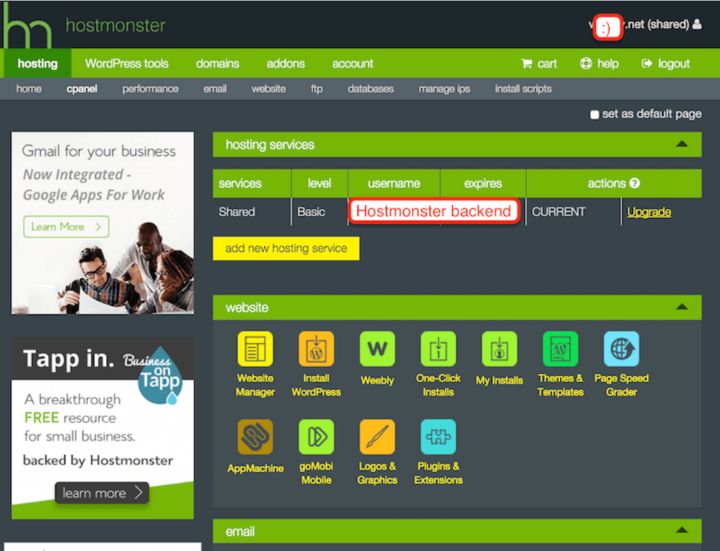
I will say I’m not a fan of the rather hideous shade of green in Hostmonster’s color scheme. I think it’s supposed to be “Monster Green?”
Back to the positives. The backend is the first thing you see after signing up, so you can dive right into your project without any intermediate screens. The most common options (like WordPress auto-install) are front and center, with server information along the side.
And users receive a confirmation email with their account info immediately after signing up.
Many providers use a proprietary backend (DreamHost and IONOS by 1&1) or clutter things up with ads and upsells (iPage) – so HostMonster’s simple backend is a big advantage.
Apps & Installation Process
Related to HostMonster’s simple, clean (though hideously green) backend is their app install process. They use an installation process by MOJO marketplace – a theme and template provider owned by Newfold Digital.
The one-click WordPress install process has a few ads and upsells but is simple and useful.
Since they use MOJO marketplace (a premium theme and template marketplace owned by Newfold), HostMonster has a solid selection of apps and scripts available. Again, all with MOJO ads, but otherwise straightforward to use and install.
Not a huge advantage, but solid pro anyway compared to other industry providers.
Cons of HostMonster
Like any web host, HostMonster has its share of drawbacks. If you’re considering HostMonster, here are the cons that I found while using them for hosting.
Pricing & Plan Structure
HostMonster’s biggest disadvantage is its standard pricing. No matter how you look at it – short-term, long-term, total value, or simplicity – HostMonster is too expensive for what they are selling.
They use the same pricing structure as Bluehost and JustHost – both of which are recent changes for the worse. In fact, HostMonster’s online signup process looks like a rebranded Bluehost shopping cart.
Either way, comparing pricing among various hosting companies is notoriously difficult. Companies have different plans with different caps, different bonuses, and different renewal prices. Figuring out what you will be paying every year or every month around can be maddening.
HostMonster has four shared hosting plans – Basic, Plus, Choice Plus, and GoPro. Although prices are listed as monthly – you have to pay on 12 or 36-month terms.
The prices listed below are the monthly prices based on paying for 36 months upfront. The best discounts are for the 12-month pricing ($2.95/$5.45/$5.45/$13.95); however, if you choose the 12-month option, you’ll be forced into paying HostMonsters steep renewal prices after only a year. Bluehost has the same pricing structure.
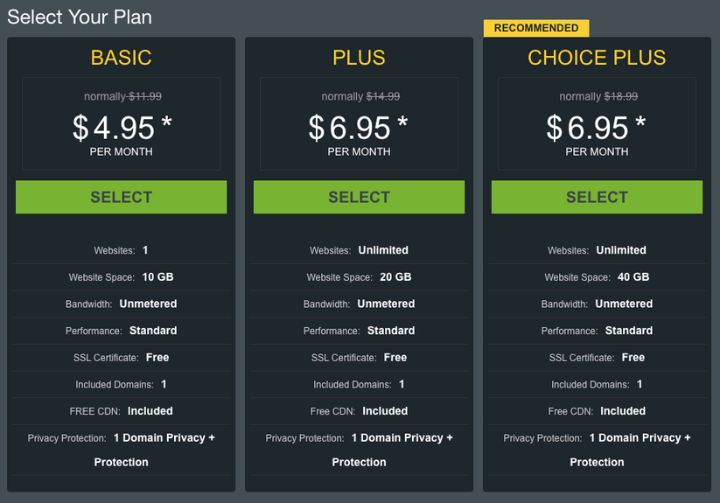

Regarding caps, HostMonster does not pre-emptively cap your usage. Instead, they reserve the right to throttle your site if you start to do too much with your server.
On the Basic plan, HostMonster heavily caps domains (1), disk space (10 GB), databases, and email addresses (5). But even for basic use, it’s more expensive than sister brands like HostGator and Bluehost.
On the Plus and Choice Plus plans – there are fewer caps, but they are both still more expensive than sister brands like HostGator or independent competitors like InMotion Hosting or Siteground.
The Plus and Pro plans try to fluff out their value with Bonus features. Most features are either of questionable value (SpamExperts), more complex than they sell (GlobalCDN and free SSL), or devalue the Basic and Plus plans (High-Performance and Automated Backups – does that mean the other plans offer bad performance with no backups?)
Either way, if you need a single website with no email or anything like that – HostMonster’s pricing is ok, but really you’d get a better product for your money elsewhere.
Customer Support
At first, HostMonster seems to be fine with customer support. They have support across email (24/7), live chat (24/7), support tickets, phone, a knowledgebase – even a user forum and video tutorials.
Unfortunately, in my experience, their user forum fails to load regularly. Their knowledge base is not as updated or as extensive as other knowledge bases that I’ve seen. It’s also littered with broken links and poor design choices. It looks like they used to invest in support resources years ago – but have since stopped.
Overall, their customer service is decent, and on its own, I’d consider it a strength. But combined with the next disadvantage and the problems I pointed out, I’ll place it in the cons column.
Branding & Design
Nobody wants to buy the product that a big company has forgotten about or is not fully invested in – even if the product itself is fine.
Think about the apartment complex that the landlord ignores instead of remodeling or upgrading. Or that car that still works, but the owner isn’t putting money into crucial maintenance.
HostMonster feels like the brand that Newfold forgot.
Their big sister brands like Bluehost and HostGator are getting splashy new designs and new services. Even iPage has gotten a design refresh.
But like FatCow and JustHost, HostMonster is sitting around with cheap stock imagery, circa 2006 design, and broken links.
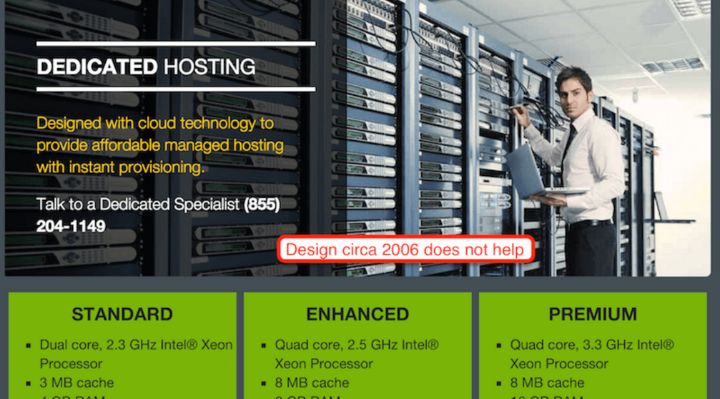
And it’s not that stock imagery or basic design is bad or affects how good their servers are. But it is an indicator of how much the management and owners care about the company and provides a window into the company culture.
Compared to their sister brands and especially independent competitors such as:
HostMonster’s outdated brand is a big disadvantage.
Mediocre Performance
There are several factors that go into how fast your website loads. Everything from what type of website you have to how many images you use to where your visitor lives (and 100+ other factors) to website speed.
However, no one ever won a Formula One car race with a 1988 Honda Civic. And no matter how well you optimize your website, you won’t be winning any speed contests with a slow hosting server.
It’s hard to judge server speed without behind-the-scenes access, so I use the Time To First Byte (TTFB) measure to estimate how well a hosting company’s servers operate.
Time To First Byte is how quickly the server sends the first byte of information back to a browser after the browser asks for it.
When I tested HostMonster with my website, they did not do too well.
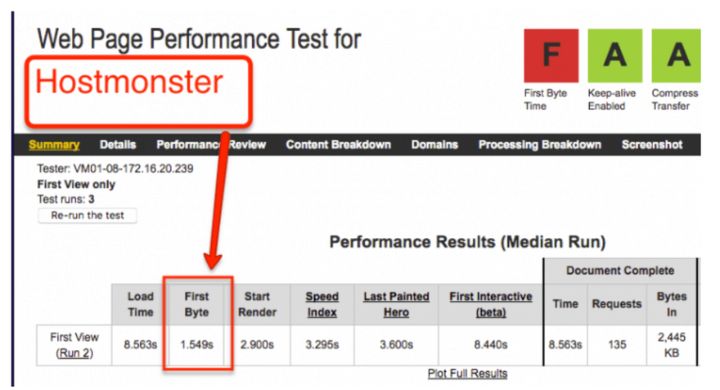
Granted, TTFB is best looked at as a trend. And since they share a data center with Bluehost, it’s maybe a one-off issue (or a misconfiguration if it’s a separate section).
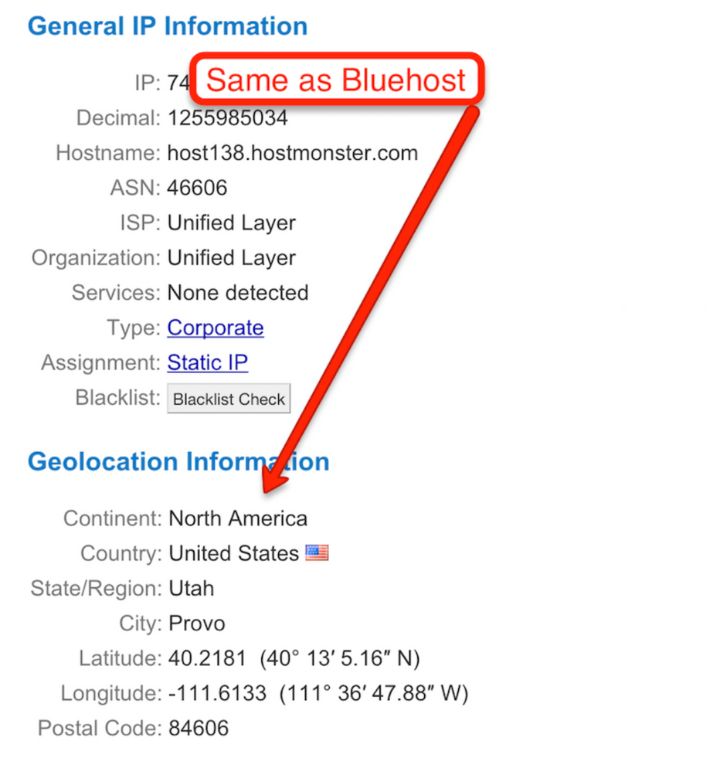
For comparison, here’s how a similar site on Web Hosting Hub (a competitor starter website hosting company) performed:

Although HostMonster would be fine for a very small site, they simply don’t have strong performance when compared to direct competitors.
HostMonster Alternatives
Out of the major web hosts that I’ve used as a customer or consultant, here’s how HostMonster compares directly to each.
HostMonster vs. GoDaddy
Despite much improvement since 2013, GoDaddy still shares many of the same pros and cons of HostMonster. Neither is an amazing choice, but HostMonster has an edge overall in my opinion. Though if your domains are registered through GoDaddy, go with them.
HostMonster vs. HostGator
HostGator is a well-known brand in the hosting industry. They are also owned by Newfold Digital, which makes them another sister brand to HostMonster – also, the names are eerily similar.
However, HostGator operates out of Houston and has a different pricing structure and brand focus. They focus more on starter websites and offer more affordable plans with better features. They also have monthly billing options. Of the two, I would choose HostGator.
HostMonster vs. Bluehost
HostMonster and Bluehost (see my Bluehost review) are sister brands owned by Newfold Digital. They share the same data center. They even have the same plans. Between the two – I’d go with Bluehost, hands down. They are one of Newfold’s marquee brands and are apparently getting a lot more attention than HostMonster. Learn more about Bluehost.
HostMonster vs. iPage
HostMonster’s last sister brand that I’ll mention is iPage. Like HostMonster, they seem to be a brand that Newfold forgot about, though iPage does much deeper discounting than HostMonster. That said, HostMonster seems to have a slightly better backend. I’d probably choose iPage, though neither is a very attractive choice.
HostMonster vs. InMotion Hosting
InMotion Hosting is one of the largest and fastest-growing independent (i.e., owned by employees, not a large corporate holding company) hosting companies.
This site uses a VPS server with InMotion. They have better pricing, better support, and better performance than HostMonster. InMotion Hosting, in my opinion, is a much better choice than HostMonster.
The Bottom Line on HostMonster
Overall, I found HostMonster to be no longer relevant as a web host. You’ll get much more value for your money with Newfold’s sister companies like Bluehost or HostGator. If you have a small website, bypass HostMonster altogether, and go with one of those two companies instead.
If you are looking for an independent shared hosting company with good pricing, better performance, and customer support, then I’d recommend you check out InMotion Hosting.
If you’re still undecided, read my best web hosting services article.






